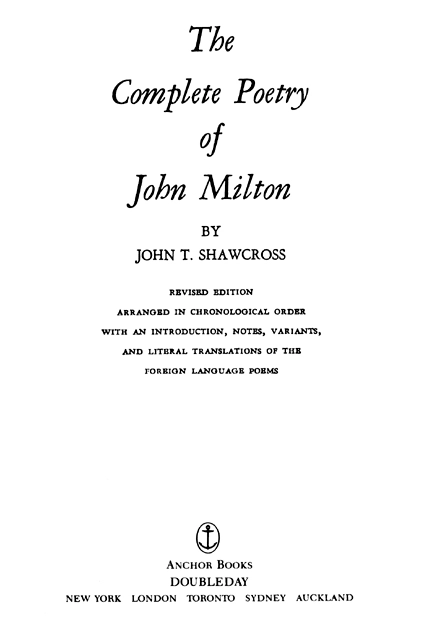The Complete Poetry of John Milton
John T. Shawcross received a Ph.D. from New York University and is now professor of English at the University of Kentucky. He is also the author of With Mortal Voice: The Creation of Paradise Lost, John Milton: A Bibliography for the Years 1624-1700, and Paradise Regain’d: “Worthy T’Have Not Remain’d So Long Unsung”.

AN ANCHOR BOOK
PUBLISHED BY DOUBLEDAY a division of Bantam Doubleday Dell Publishing Group, Inc. 1540 Broadway, New York, New York 10036
ANCHOR BOOKS, DOUBLEDAY, and the portrayal of an anchor are trademarks of Doubleday, a division of Bantam Doubleday Dell Publishing Group, Inc.
This edition has been especially prepared for Anchor Books and has never appeared before in book form.
A Penguin Random House Company
eBook ISBN: 978-0-307-82376-2
Trade Paperback ISBN: 978-0-385-02351-1
Library of Congress Cataloging-in-Publication Data
Milton, John, 1608-1674.
[Poems]
The complete poetry of John Milton: arranged in chronological order with an introduction, notes, variants, and literal translations of the foreign language forms by John T. Shawcross.—Rev. ed.
p. cm.
Includes bibliographical references.
I. Shawcross, John T. II. Title.
PR3551.S4 1990 89-77299
821′. 4—dc20 CIP
ISBN 0-385-02351-0
Copyright © 1963, 1971 by Doubleday, a division of Bantam Doubleday Dell Publishing Group, Inc.
ALL RIGHTS RESERVED
v3.1
Introduction to the Revised Edition
Arranged according to probable date of composition of the verse, this revised edition brings together all original poems and poetic paraphrases written by John Milton. Included therefore are nine poems not published in either of the two collected editions of the minor poems appearing in Milton’s lifetime: two verses found with his Commonplace Book, a third poem on Hobson the university carrier possibly by Milton, four sonnets, and two Latin epigrams from two prose works. Poems written in Latin, Greek, and Italian are given in original versions and in new prose translations, which attempt insofar as possible to follow the original lines. Differences from the first edition of this collection include the addition of the foreign language texts and the texts of Psalms 80–88, additional notes, a general updating of materials, and some rearrangement of the poems.
I have attempted to narrow the dates of composition as much as is presently possible; when apparent proof of date is missing a question mark is added. But the reader should bear in mind that such dating is open to question and it may be in dispute by scholars. Full discussion of dating will be found in the textual notes. Milton frequently altered poems after he had recorded them in the earliest versions which have survived, but perhaps only Arcades, A Mask, Samson Agonistes, Paradise Regain’d, and Paradise Lost underwent extensive revisions. Dates for such development are indicated and the poems placed in this arrangement accordingly. Paradise Regain’d has been positioned after Paradise Lost because the received text is apparently an extensive transformation into epic form of whatever was its early version. Samson Agonistes has been rearranged in this revised edition, not because I have altered my belief concerning its date of composition, but because its former position isolated some of the minor poems from others, creating a frankly odd arrangement. It is perhaps best to place the three major poems together, and the standard placement of Samson Agonistes last allows one to contrast it effectively with Paradise Regain’d in interpretation and form. The dating of the three major poems is, in any case, particularly uncertain and has been frequently challenged.
Explanatory notes present information necessary to an understanding of the poetry for the student and general reader and, hopefully, readings suggestive of structure, biographical contexts, sources of importance, and import for Milton. No attempt has been made to present a history of ideas, a frequent approach to a study of Milton. Textual principles are explained in the introduction to the textual notes. Generally, the basic text is that which seems to be closest to Milton—holograph, then scribal copy, and so forth. Alterations from the basic text are few; and all verbal variants in known significant texts are recorded in the textual notes. All dates for years are given in new style. Milton’s prose works are cited from first editions.
The advice and knowledge of Professors J. Max Patrick and William B.
1 comment